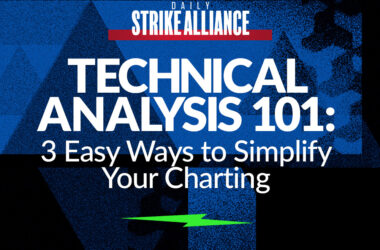Happy Wednesday, traders…
Ben here.
When you trade a stock, you only really have two choices: long or short.
But when you trade options, you have many more … well, options.
This often trips newbies up. When people try to trade options for the first time, they’re often overwhelmed by the sheer complexity of the market.
I’ll notice students “throwing darts” at the market, unsure of what they’re trying to accomplish.
Look, there are hundreds of thousands of options contracts to choose from daily.
Strike prices, expiration dates, volume, open interest, The Greeks … it’s a lot to digest.
I recently wrote about trading like a farmer: being patient and waiting for the perfect opportunity to harvest. Competent farmers know what they need to sow their seeds.
The question is: Do you know what you’re looking for in the options market?
After 20+ years in the markets, I know what I’m looking for in a potentially winning trade.
Today, I’m going to show you the four factors I look for in an options trading setup…
Step #1: Smart Money Sweeps
More than anything else, I want an unfair advantage — an undeniable edge in this vast marketplace.
That’s why I focus on trading contracts with big ‘smart money’ sweeps … I’ve seen how powerful these setups can be.
After all, since building my Spyder Scanner, I’ve achieved an 84% win rate* across all of my options trades.
You see, what sets big institutional ‘smart money’ apart from retail traders in their Mom’s basement is information.
By following the ‘smart money,’ I give myself a huge leg up over my competition.
I can base trades on the ‘smart money’s’ data without actually having it.
I don’t need to know the material, non-public information these mysterious traders might be using…
I simply need to know what to look for, pay close attention to the ‘smart money’, and pull the trigger when the opportunity presents itself.
But even if you narrow your potential ‘options’ down to ‘smart money’ bets from my Spyder Scanner, you’re still left with a lot of contracts to choose from.
Then, it’s time to verify the next step…
Step #2: Options Volume
Volume is a way to see how many contracts people traded on a specific underlying stock during one day. It’s like counting the number of apples sold at a market daily.
Think of volume as a snapshot of near-term demand for options contracts.
For short-term (and day) traders, volume becomes super important. It’s like a heartbeat, showing the size and action of the market for that day.
Imagine there’s big news, like a company announcing a new product. This could make a lot of people want to buy a specific contract.
When they do, you’ll see that contract’s volume shoot up. It’s like a big flashing sign saying, “Hey, look over here! These contracts are flying off the shelves!”
By keeping an eye on options volume, you can get a feel for what contracts have high demand (and which don’t).
This can give you double-confirmation of where the smart money is flowing, beyond what you see on my scanner.
Step #3: Open Interest
If volume measures short-term liquidity, then open interest is its long-term counterpart.
Open interest represents the total number of active or “open” options contracts for a particular strike price and expiration date.
In simpler terms, it tells you how many contracts are currently held by buyers and sellers.
Here’s how open interest is calculated:
When a buyer and seller both enter a new trade (one buys a new contract, and the other sells a new contract), open interest increases by one.
If a buyer sells an existing contract to a new buyer, the open interest remains unchanged because no new contract was created — it was merely transferred.
By monitoring open interest this way, you can track where the ‘smart money’ is moving … and staying.
Step #4: Chart Patterns
Options trading is all about direction.
If the underlying stock doesn’t go in the direction of your contracts, your position is toast.
So, after identifying a smart money sweep with big volume and open interest, my next step is to confirm the setup on the chart.
There are two directional chart patterns I’m always on the lookout for:
The Breakout Pattern
A breakout occurs when a stock surpasses its support or resistance levels.
These levels represent the price points where the stock has struggled to move beyond during a specific period.
Breakouts are a strong indicator that the stock is likely to continue its trend, you could be in at the beginning of something BIG…
But there’s a catch…
Some breakouts eventually prove to be false breakouts — when a stock cracks a key level, lulling traders into a trap, only to quickly drop back below (or above) it.
And the key to identifying a breakout vs. a false breakout is daily trading volume.
If I see a stock crack a resistance level on low volume, I won’t be rushing to buy calls.
But if I see a break above a key level with huge daily trading volume — ideally bolstered by even more options volume — I’m far more likely to trade that setup.
Example: On Wednesday, June 26, I sent a text message alert to Spyder Members that said: “AMZN about to break $189. Watch the 7/19 $195 calls over that level.”
(If you look at the chart, $189 was a very clear resistance level…)

Sure enough, AMZN cracked through $189, and I bought those calls for $2.70.
The stock surged to over $200 and I scaled out of the calls yesterday for $8.00 — a gain of 196% in less than a week.*
The Pullback Pattern
The Pullback Pattern is exactly what it sounds like…
The share price “pulls back” to a support level — often after a strong move higher.
This is due to profit-taking. Traders hit their price target and sell — often at an important round-number price level — causing a pullback.
Then, after holding the support level, the price reverses back to the upside.
Contrary to breakouts, pullbacks usually work best on lower volume.
You want to see big volume during the bullish rally, followed by lower-volume selling and consolidation back to support.
CAUTION: If there’s enormous selling volume, that’s usually a sign there’s something seriously wrong (i.e. the COVID crash of March 2020). That’s not what we’re looking for with pullback trades.
The benefit to pullbacks is that you can get a great entry price, especially if you’re trading options.
A few minor red days after a big run-up can take a huge bite out of call option premium, giving you a beautiful entry point for your trade.
And speaking of entry points, let’s look at:
💰The Biggest Smart-Money Bets of the Day💰
- $10.6 million bullish bet on TSLA 07/05/2024 $225 calls @ $4.13 avg. (seen on 7/2) [RISKY]
- $5.03 million bullish bet on COIN 07/19/2024 $260 calls @ $3.35 avg. (seen on 7/2)
- $3.07 million bullish bet on V 10/18/2024 $280 calls @ $5.60 avg. (seen on 7/2)
P.S. Are you tired of wasting time and money on losing trades?
Well, then it’s time to start sharpening up your strategy…
This FRIDAY, July 5 at 8:30 a.m. EST — my colleague Danny Phee is hosting an urgent LIVE WEBINAR where he’ll reveal the most promising ‘smart money’ trades we’re seeing this week.
Don’t miss out — CLICK HERE NOW TO RESERVE YOUR SEAT.
*Past performance does not indicate future results





